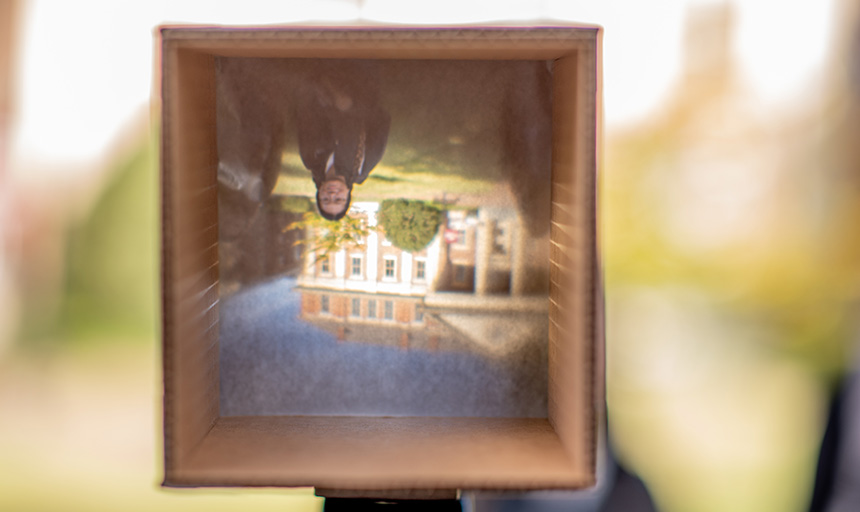Center for Studying the Structures of Race hosts Camera Obscura exhibition
April 05, 2023

By Margo Boone '26
One of the Center for Studying Structures of Race’s (CSSR) key focuses is acknowledging that many structures on campus were built by enslaved people. Founded in 2019, CSSR was established to thoughtfully respond to issues of race. Their latest project is an exhibit, housed at the former slave quarters located outside Monterey House, that employs 19th-century technology and encourages guests to look at the structures through a different lens.
The exhibit features pictures, taken by students in INQ 300: Memorials, Monuments and Memory, of places on campus that were named for enslavers or that memorialize the Confederacy, such as Roanoke County’s Confederate monument on the corner of College Avenue and East Main Street. The students used handmade camera “obscuras,” a process chosen to illustrate the importance of inverting reality to see spaces on campus in a new way.
The camera obscura effect uses a dark chamber with a small hole cut out to let light pass through. The light will then project the image on the surface in front of the box. This gives the appearance that the photo is upside down. To further the understanding of this technology, CSSR also created an immersive experience that replicated for guests what it was like inside of the chamber. The inverted images invite viewers to engage in a closer consideration and critique of the buildings.
The project was led by Jesse Bucher, CSSR director and College Historian, as a means of challenging our sense of reality and allowing us to see campus spaces in a new light. Engaging students in the work was crucial, Bucher said.
“Students are at the core of everything we do at the CSSR. The major research projects, CSSR’s Maurice Berger archival collection, and exhibits like Camera Obscura all thrive with the expertise and skills of students. Student workers at the CSSR gain important academic and professional experience, but they are also my creative and intellectual partners,” he said.
I think it's because it is our history. RC is big about coming back to our roots and being part of the community. I think that for students, it is important to be involved in this and for our art to be featured because it is about us.
~ Michele Eaves ’24
Many students were eager to share the piece as they believed it shed light on an important part of Roanoke College’s history. When asked why it was important for students to get involved in the exhibit, Michele Eaves ’24 said the following:
“I think it's because it is our history,” said Eaves, a sociology major and student worker at CSSR. “RC is big about coming back to our roots and being part of the community. I think that for students, it is important to be involved in this and for our art to be featured because it is about us. If RC claims to be about the students, we are going to be about the students.”
The students also stressed how important it was for Roanoke College to acknowledge the past in order to grow. People on campus admire the architecture but should also understand the history behind it. Exhibitions like Camera Obscura evoke conversations and inspire viewers to look at their surroundings through a new point of view.
The Camera Obscura exhibit hosted guided gallery hours in March. It will remain on display through the summer and be viewable by appointment. For more information, contact Jesse Bucher at bucher@roanoke.edu.
